What the ... ?
As I was putting the finishing touches on last week’s newsletter, I received an email from Dowe Winchell of Greenville-Spartanburg Airport. Dowe showed me a couple of pictures from his neighbor’s back yard. The first one showed multiple holes in the ground. It puzzled me for a minute, until I scrolled down the email and saw the second picture. Eureka! I had seen the critters that created these holes. I went to my driveway and found a similar hole, which was slightly smaller than a nickel. I also found the culprit on an old fence post nearby.
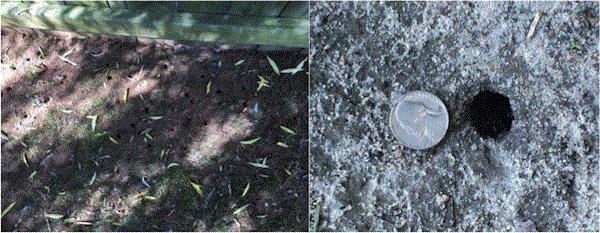
I saved the puzzle for this week’s “What the … ?” What do you think made these holes? Scroll down to the end of this newsletter to find out.
Cercospora leaf spot on hydrangea
It’s probably a good thing that I don’t live in a subdivision and my nearest neighbor (who is my mother-in-law) can’t see my yard from her house. I have an award-winning mixed-species lawn that’s so species-rich that it’s a fully functioning ecosystem. I don’t mind dallisgrass in the zoysiagrass “lawn” or mosses under the dogwood trees. Those tiger beetles running all over the place are my friends. In fact, land around my house provides plenty of materials for my show-and-tells on pest identification.
I’ll show you a few interesting things I found around my house in the last couple of weeks.
My wife loves the two hydrangea bushes at the corner of our house. Her granduncle Jack planted them and they survived all the neglects I dished out at them. I started to find cercospora leaf spots on them in early June, and the disease has become progressively worse as our hot, rainy summer continues. I also found them on the hydrangeas in the nursery plots at work.
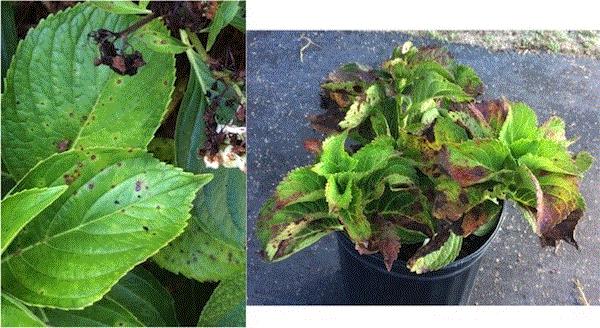
Cercospora leaf spots on bigleaf hydrangeas at my house (left) and from my "What-in-the-world-happened" line of products (right).
Cercospora leaf spot, caused by Cercospora hydrangeae, is a common and devastating fungal disease of hydrangeas in landscapes and nurseries. On bigleaf hydrangeas, the symptom first appears as circular purple spots, which enlarge and become light gray in the center with a purple halo around the spots. The leaf spots on oakleaf hydrangea seem more angular to me. Chlorosis appears on severely spotted leaves, which eventually fall to the ground.
The fallen leaves become a source of spores for reinfection. Therefore, removing fallen leaves is paramount to keeping the disease at bay. Drip irrigation is recommended because rain and overhead irrigation splash spores onto the foliage.
Fungicides are largely preventive and should be applied as soon as the disease is detected. Repeated foliar sprays of products containing FRAC Group 1 (thiophanate methyl), 2 (iprodione), 3 (metconazole, myclobutanil, propiconazole, tebuconazole, triadimefon, triticonazole), 7 (benzovindiflupyr, boscalid, fluxapyroxad), 11 (azoxystrobin, fenamidone, kresoxim methyl, trifloxystrobin), 19 (polyoxin D zinc salt), M3 (mancozeb), and M5 (chlorothalonil) have good efficacy against fungal leaf spots. Remember to read the labels for application rates, instructions and restrictions.

Twig pruners are pruning
A summer thunderstorm came through two evenings ago and knocked down a few twigs from the water oak in front of my house. Before I even picked up the twigs, I knew why they fell off so easily in a mild storm: twig pruners had already weakened them.
Twig pruners are a group of longhorned beetles (also called roundheaded borers). The two common species in my area are Anelaphus parallelus and Anelaphus villosus. Adults are reddish brown beetles with elongated bodies (0.75 in. long) and long antennae (the namesake “long horns”).
Adults fly around in the spring and lay eggs on the tip of twigs of various hardwood species. There’s usually one egg per twig. The egg hatches, and the larva bores into the twig and hollows out the pith as it mines down the stem. The larva overwinters in the twig, and resumes feeding next spring. In the summer of the next year, mature larva cuts around the stem but leaves the bark intact. The larva then plugs the hole with frass or fiber (you can see the plug in the center of the stem). The internally-pruned twig slowly dies. The thin bark holding the pruned twig to the tree breaks during a storm and the twig falls to the ground. The larva pupates inside the twig on the ground, and the adult emerges in the spring.
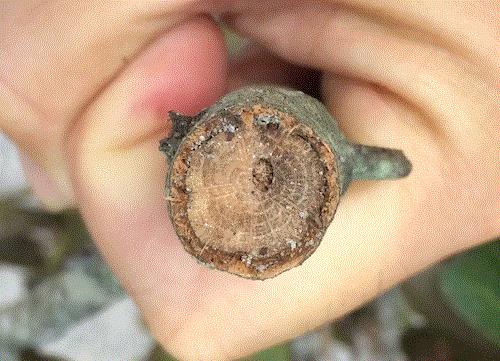
Twigs pruned by the twig pruners can be easily identified: smooth wood on the inside, a plug in the center, and a rugged, protruding bark on the rim.
The behavior of pruning the stem from within is quite unique, and creates a telltale sign for identification. Twigs cut by twig pruners have a smooth surface on the wood, with a plug in the center and bark protruding from the pruned surface. Twigs cut by twig girdlers (which is another group of beetles that can cause fallen twigs), on the other hand, are smooth on the outer rim and rugged in the middle because adult beetles cut the twigs from the outside.
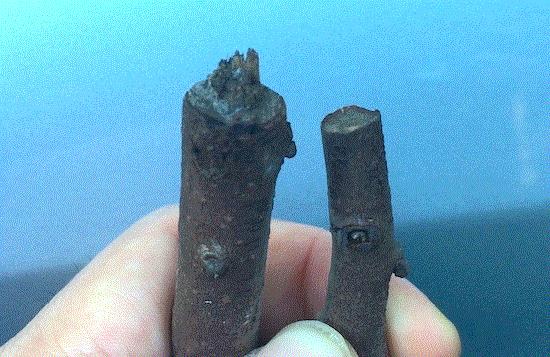
Persimmon twigs cut by twig girdler (left) and twig pruner (right).
Losing a few twigs will not hurt a mature tree, but severe pruning may change the eventual form of a young tree. Treatment with insecticides is not feasible because the larvae are feeding inside the stem and the adults are everywhere. The best way to deal with this critter is to collect all the fallen twigs and burn them. You can also just throw the twigs away but remember to throw them far away from your trees. Otherwise, the adults will fly right back.
Fall webworms are webbing
Fall webworms are having a feast on the pecan, hickory, persimmon and sweetgum trees around my house. Fall webworms create an unmistakable sign—a large web that envelops a terminal branch. Inside the web are dozens to hundreds of caterpillars that hide inside the web during the day and emerge to feed and expand the web at night. Fall webworms can cause serious defoliation on some species. Sometimes, a small tree can be completely covered with webs and become totally defoliated.
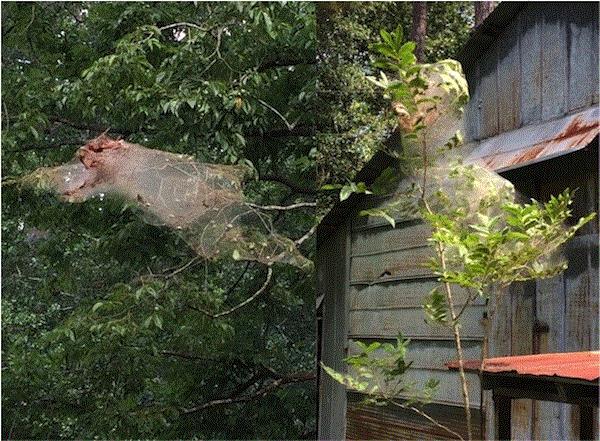
Fall webworm webs enveloped a persimmon terminal branch (left) and the entire canopy of a young hickory tree (right).
Adult fall webworm is a white moth with a wingspan of about 1 in. Females deposit masses of hundreds of eggs under the leaves. Despite its common name, the fall webworm usually appears in the summer. When fully mature, the caterpillars are about 1 in. long. They crawl or drop to the ground to pupate. There are two generations per year in South Carolina, with each generation lasting about 60 days.
Although the webs look rather ugly and seem damaging, I have never seen the infestation hurting or reducing nut yields from mature trees. So, I usually just leave them alone. Except when they feed on the persimmon tree in front of my mother-in-law’s pottery studio. She has an exhibition every October and she doesn't like having these ugly things over the heads of her guests. So, I usually get a long pole, break up the webs, and wait for the birds, assassin bugs and parasitic wasps to come and clean up the caterpillars. Easy peasy, and it makes me her favorite son.
Under no circumstance should you burn the webs and risk injury or damage. Not with a tiki torch, rolled up newspaper, nor a flamethrower. Buneng, nahee, kann nicht, ne mogo, la tastatie, haiwezi, dekinai, and in any other language you want to say ‘"cannot".
Going back to my initial comment about my mixed-species lawn. I don't do anything to control these “pests” I mentioned earlier because, in my mind, they’re not pests. A plant, insect or fungus becomes a pest when it bothers us by harming or disfiguring the plants we love. None of the “pests” I saw these past two weeks bother me so I just let them be. I know I’m philosophizing but I’m also being practical—if I don't fuss over things that don't bother me, I have more time for things that I really love and enjoy. Or, spend the dimes I saved from not buying pesticides on the bottomless money pit that is a boat.

Answer to the "What the ... ?" mystery
The second picture Dowe showed me was the critter in question—a nymph of dog-day cicada. I use “dog-day cicada” as a general grouping that includes several species that look remarkably similar. The species that is commonly referred to as the common dog-day cicada, Neotibicen canicalaris, is more widespread in the northeastern U.S. and the adjacent Canadian provinces. The one Dowe showed me was likely a Davis’ southeastern dog-day cicada or the southern dog-day cicada, Tibicen davisi, which is more common in my neck of the woods. I couldn’t identify the species accurately based on a picture of a mature nymph.
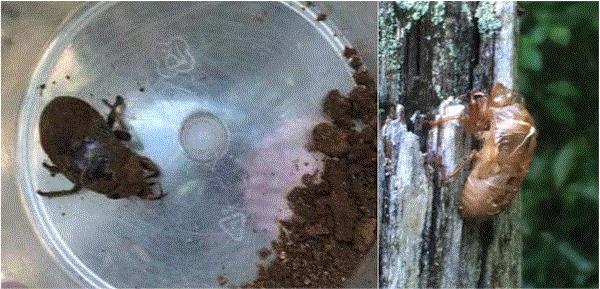
This is an annual cicada, i.e. the life cycle is completed within one year. Nymphs suck sap from the roots of pine and oak trees. Adults appear every summer; to me, they are the unmistakable sign of summer. Their songs, which are described as “a short brassy buzz-saw like sound lasting about 10 seconds” by Cicadas.info, are in a fever pitch at this moment. A friend who just moved here from Seattle found the volume disturbing.
You know what’s louder than these dog-day cicadas? Periodical cicadas. Brood VII (or the Onondaga Brood) of the 17-year periodical cicada is in full swing in the Finger Lakes region of New York State. Brood VIII will become active in eastern Ohio, western Pennsylvania and northern West Virginia in 2019. Folks should watch for oviposition damages to tree branches in these areas. I’ll have to wait until 2024 for Brood XIX (or the Great Southern Brood) to emerge in South Carolina.
Broadform from Bayer
Bayer will soon introduce Broadform, a new combination fungicide that includes fluopyram (FRAC 7 or SDHI) and trifloxystrobin (FRAC 11 or QoI). The same combination has already been introduced as Exteris Stressgard in the turf market for dollar spot, brown patch and leaf spots (among others) control.
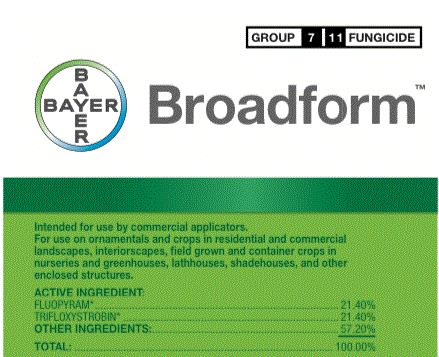
Many of us are familiar with trifloxystrobin, which is known as Compass in the U.S. and Canada. Fluopyram, on the other hand, is an active ingredient that’s new to the ornamental market. Fluopyram was first introduced to the field crop market in 2009. Fluopyram is also the active ingredient in Indemnify, a nematicide registered for the turf market.
Broadform is registered for management of foliar and stem diseases, such as aerial phytophthora, alternaria, anthracnose, botrytis, powdery mildew, septoria leaf spot, rhizoctonia stem rot, rust and scab. Foliar nematode is not on the label. Application rate for foliar diseases is 2 to 8 fl. oz. per 100 gallons. The maximum amount of Broadform allowed per year or crop cycle is 27.1 fl. oz. per acre.
Registered use sites include greenhouses, field and container nurseries, residential and commercial landscapes and interiorscapes. REI of Broadform is 12 hours.
Bayer will officially introduce Broadform at Cultivate’18. Visit Bayer’s booth and find out more about this new fungicide from Aaron Palmateer and his colleagues. Broadform will be available for purchase in September 2018.
Are you going to Cultivate’18? I am.






See you in Columbus!

JC Chong
Associate Professor of Entomology at Clemson University
This e-mail received by 24,603 subscribers like you!
If you're interested in advertising on PestTalks contact Kim Brown ASAP!